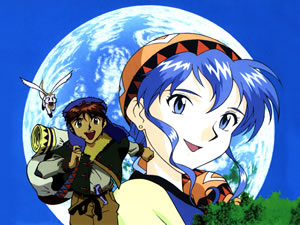 Many people criticize the Sega CD. Too many FMV games, not enough quality titles, etc; the list goes on and on. While somewhat unfair, there is a grain of truth to be found in these claims. There weren’t enough sports titles (imagine what could have been done with, say, World Series Baseball at the time) and many platformers were simply ports with a red book soundtrack. Far too many people shied away from the system before really giving it a chance. One area where criticism is most definitely unfounded is the RPG genre. The Sega CD gave us some great titles and while it’s not a large offering, the quality is there. Dark Wizard, Eye of the Beholder, Shining Force CD; good stuff indeed.
Many people criticize the Sega CD. Too many FMV games, not enough quality titles, etc; the list goes on and on. While somewhat unfair, there is a grain of truth to be found in these claims. There weren’t enough sports titles (imagine what could have been done with, say, World Series Baseball at the time) and many platformers were simply ports with a red book soundtrack. Far too many people shied away from the system before really giving it a chance. One area where criticism is most definitely unfounded is the RPG genre. The Sega CD gave us some great titles and while it’s not a large offering, the quality is there. Dark Wizard, Eye of the Beholder, Shining Force CD; good stuff indeed.
Working Designs led the RPG charge by releasing four awesome games. Popful Mail was an incredible side scrolling action/RPG that needs to be re-released and Vay, though frustrating with its random battles, was a neat little romp with one of the first character deaths on console (Phantasy Star II beat them to it). Their greatest achievements, without a doubt, have to be the two Lunar games.
By taking advantage of the Sega CD medium, Working Designs brought Game Arts’ complex tales of love and sacrifice to a western audience that was instantly enthralled. Encased in some primo packaging and sporting a multitude of different labels (Silver Star had seven!), the duo quickly became two of the best-selling Sega CD titles ever made. Such was their popularity that they were both re-released on Saturn (in Japan) and in mouth-watering deluxe sets for the PlayStation.
Just what was it about these games that made them such huge hits? To answer that, we need to take a look at them individually.
Lunar: The Silver Star
Released in December, 1993, The Silver Star took gamers by surprise with its animated story cut scenes and glorious soundtrack. While not the first game in the genre to use this format (Turbo Cd games such as Ys and WD’s own Exile had already been wowing gamers since 1990), it was the first one to really gain such monumental exposure in the U.S. By 1993, the Turbo Duo had all but dissipated from the domestic market and most people had been unable to partake of its great library (yes, I said great). By the time Lunar came around, they were eager for a reason to believe in the CD format. What they got became the best-selling Sega CD title of all time.
Stuck in the town of Burg, young Alex wishes to be like his idol, Dragonmaster Dyne. He yearns for adventure and excitement but seems to be going nowhere. That is, until his friend Ramus convinces him to take his destiny into his own hands. Accompanied by Alex’s sweetheart Luna, the two embark on a quest that extends beyond their wildest dreams and takes them to the farthest reaches of the globe. The game really did an excellent job overall of making you care about the characters and what was going on.
Of course, an excellent story deserves some quality trappings. A wonderful soundtrack and great voice work complete the package, making it quite clear that this is not another run-of-the-mill RPG. Sure, the opening theme song was a bit on the cheesy side but that was part of the charm and it actually grows on you pretty quickly. It all came wrapped in a beautiful foil-covered manual and back insert. It was quality packaging like this that gave Working Designs its well-deserved reputation and was something the company maintained with its releases until the very end of their run in early 2006. Of course, many gamers to this day debate as to whether or not the desire to dress their titles in such great fashion was what caused them to release so few games per year.
An interesting note about Silver Star is the fact that Working Designs pressed seven different CDs (actually, they pressed six. The first was done by Sega). Each CD boasted a unique Lunar image and made them quite collectable. The seventh disc is the rarest, with the Sega-pressed disc being the most common. WD continued this practice with many of their later releases, inciting gamers to acquire multiple copies of a single title.
For more information about Lunar: The Silver Star, read our complete review!
Lunar 2: Eternal Blue
How do you follow up the top-selling game for a system? By releasing it’s incredible sequel! After the stellar sales of the first game, Working Designs wisely snapped up the rights to the sequel and released it as their last Sega CD title in 1995. The level of quality attained in the first game was ramped up for Eternal Blue and the final product made thousands of gamers everywhere do the happy dance.
Set a millennium after the first Lunar, the sequel picks up with a new hero (aptly named Hiro) who uncovers the mysterious Blue Spire and its enigmatic female resident, Lucia. Hiro agrees to help her find the goddess Althena, who is the only one capable of stopping the return of the evil Zophar. They are aided along the way by many heroes, each with a unique and charming personality.
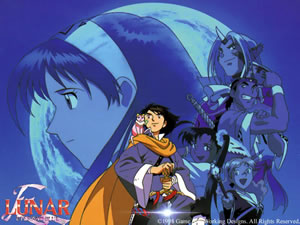 Eternal Blue continues to develop the main themes of the series in grand fashion. There are now over fifty minutes of animated cut scenes as well as ninety minutes of dialogue. The story is very well written and there’s an interesting plot twist that culminates in a classic final confrontation. The more expensive of the two games, it is still well worth tracking down, as it stands up quite nicely to its Playstation remake. Many people took issue with the save system WD implemented when they did the conversion, but I find that it does nothing to detract from the gameplay.
Eternal Blue continues to develop the main themes of the series in grand fashion. There are now over fifty minutes of animated cut scenes as well as ninety minutes of dialogue. The story is very well written and there’s an interesting plot twist that culminates in a classic final confrontation. The more expensive of the two games, it is still well worth tracking down, as it stands up quite nicely to its Playstation remake. Many people took issue with the save system WD implemented when they did the conversion, but I find that it does nothing to detract from the gameplay.
There’s also an epilogue, which lets you play for a bit more after the final battle. I found this to be quite nice, as it serves to resolve any subplots that might be left. You have to listen to Lucia’s theme in its entirety (it’s a pretty long song) to get to it, but it’s well worth the effort. You can even save it separately.
Regardless of whether or not you have the remakes, the Sega CD versions of these two classic titles still hold up very well by today’s standards. There are many differences between them as well. Silver Star has a different soundtrack than its PS cousin (although that version included it on the soundtrack CD in the deluxe package) and Eternal Blue has many dungeons and bosses that are not found in the remake.
For more information on Lunar: Eternal Blue, read our complete review.
Below are the seven CD labels for Lunar: The Silver Star.

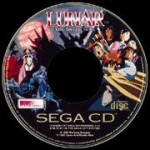
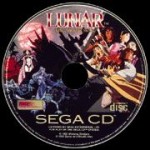
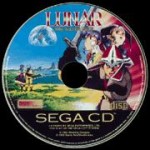
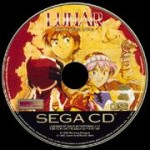
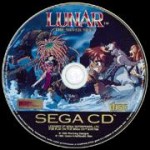
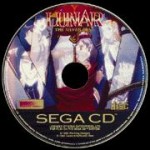
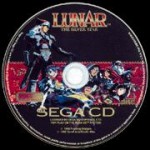
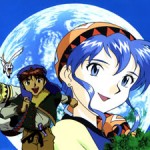
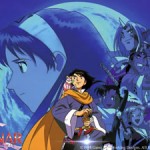
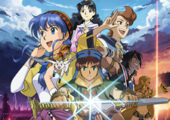
Recent Comments